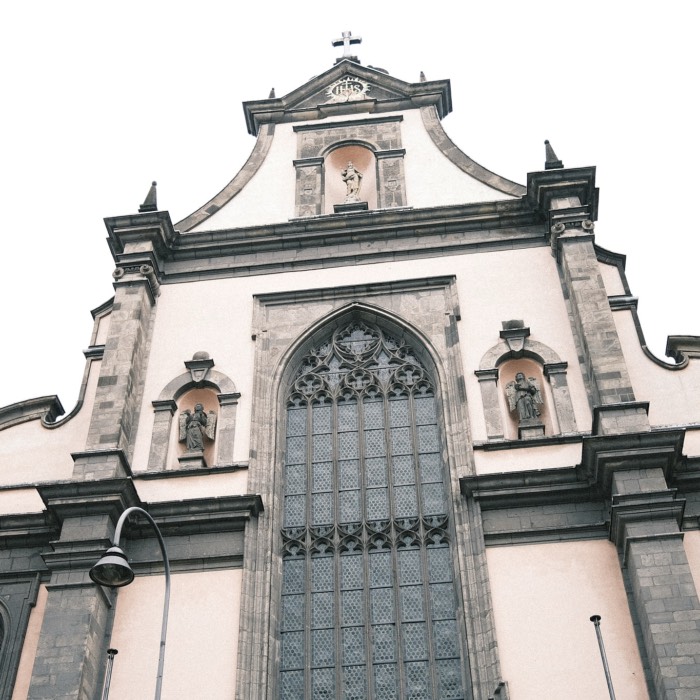Trinitatiskirche: Historical Protestant church in the heart of Catholic Cologne
The Trinitatiskirche, located in the southern part of Cologne’s Old Town near the Heumarkt, is the oldest Protestant church built on the left bank of the Rhine in Cologne. As a significant landmark for the city’s Protestant community, it represents both religious history and modern cultural engagement. Today, the church serves not only as a venue for special religious services but also as a space for concerts, events, and art exhibitions. Additionally, it is a regular place of worship for the city’s deaf evangelical community. Unfortunately, I didn’t have the chance to visit the church so far. However, in this post, I’d like to summarize its historical background as far as I could find out.
 Trinitatiskirche in Cologne, seen from the Filzengraben. I took some pictures of the church during a walk through the city in February 2024. Unfortunately, the building was closed at that time.
Trinitatiskirche in Cologne, seen from the Filzengraben. I took some pictures of the church during a walk through the city in February 2024. Unfortunately, the building was closed at that time.
Historical background and construction
The history of the Trinitatiskirche is closely tied to the political changes of the late 18th and early 19th centuries. After the French occupation of Cologne in 1794, Protestants were finally allowed to freely practice their religion in the city. Initially, they were granted the use of the Antoniterkirche. However, as Cologne became part of Prussia in 1815 and the Protestant population grew, the Antoniterkirche soon became too small to accommodate the increasing number of worshipers. By 1850, with the support of King Friedrich Wilhelm IV of Prussia, the Protestant community acquired land on the Filzengraben, where the Trinitatiskirche now stands.
The church’s design was heavily influenced by King Friedrich Wilhelm IV, who insisted that the Protestant church should distinguish itself from the predominantly Romanesque and Gothic Catholic churches in the city. He suggested a style based on early Christian basilicas, leading to a competition for designs. However, none of the initial proposals found favor, and the renowned architect Friedrich August Stüler, who had previously built churches in and around Berlin, was commissioned to present a design. In 1857, the foundation stone was laid, and by 1860, the church, with its approximately 1,000 seats, was consecrated.
During World War II, the Trinitatiskirche was heavily damaged by an air raid in 1943, leaving it almost entirely in ruins. The painstaking process of reconstruction began in 1952 and lasted until 1965. Efforts were made to restore the church to its original design, and in 1982, the Trinitatiskirche was officially placed under historic preservation.
In recent decades, the Trinitatiskirche has become a key venue for Cologne’s art scene. The church’s spacious interior and galleries are often used for exhibitions of modern art and installations. Following the installation of a new organ in 2009-2010, the church has also become a prominent location for musical performances, including classical concerts and operatic productions.
<a href=”https://live.staticflickr.com/65535/5407898452901850c3937_b.jpg” title=”Ausstellungseröffnung„Willkommen_im_alten_Köln”-7969.”><img src=”https://live.staticflickr.com/65535/5407898452901850c3937_b.jpg” width=”100%” alt=”Ausstellungseröffnung„Willkommen_im_alten_Köln”-7969.”/></a> View through the nave. Opening of the exhibition “Welcome to Old Cologne”. Source: Wikimedia Commonsꜛ (license: CC BY-SA 4.0)
 View through the nave to the organ. Source: Wikimedia Commonsꜛ (license: CC BY-SA 4.0)
View through the nave to the organ. Source: Wikimedia Commonsꜛ (license: CC BY-SA 4.0)
Architectural design and features
The Trinitatiskirche is a striking example of classicist architecture, designed in the form of a basilica with galleries running along its side aisles. Stüler’s design is characterized by simplicity and light, with the church integrated into the surrounding urban landscape. To address the challenge of light, as the building is embedded within the city block, Stüler built the structure upwards. Large windows were strategically placed to allow natural light to flood the interior, creating a bright and airy atmosphere.
 Trinitatiskirche and it bell tower.
Trinitatiskirche and it bell tower.
At the church’s entrance, a broad portico modeled on Northern Italian basilicas welcomes visitors. Behind the choir area, Stüler positioned a 41-meter-high tower that serves as a visual counterpoint to the church’s façade. The tower’s darker masonry contrasts with the light tuff stone of the main building, further emphasizing the architectural inspiration drawn from Italian campaniles.
Conclusion
Although the church no longer hosts regular congregational services due to the depopulation of the inner city, it remains an important site for special events and services within the Evangelical Church in Cologne. Its unique combination of historical significance and modern cultural relevance continues to draw both worshippers and art enthusiasts alike.
The Trinitatis Church was important for the establishment and consolidation of Protestantism in Cologne, which until then had been dominated by its Catholic heritage. Today, the church stands as an architectural gem, while being a cultural hub that bridges the gap between the city’s religious past and its contemporary developments. The church’s commitment to hosting a diverse range of events, from religious services to art exhibitions, reflects its ongoing relevance as a space for cultural engagement.
References and further reading
- Wikipedia article on the Trinitatiskircheꜛ
- Website of the Trinitatiskircheꜛ
- Jürgen Kaiser, Florian Monheim, Die großen romanischen Kirchen in Köln, 2017, Greven Verlag, ISBN: 9783774306875
- Ulrich Krings, Otmar Schwab, Köln, die romanischen Kirchen - Zerstörung und Wiederherstellung, 2007, Bachem, ISBN: 9783761619643
- Hiltrud Kier, Die Romanischen Kirchen in Köln, 2014, Hrsg.: Förderverein Romanische Kirchen Köln e. V. 2. Auflage, ISBN: 978-3-7616-2842-3













comments